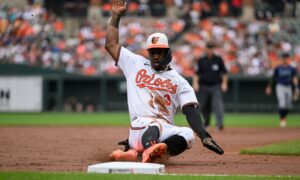Analysis: Given the obstacles, landing Miley and Pearce is a satisfactory deadline haul
SCROLL DOWN TO READ ARTICLE
The best way to describe what the Orioles did at the non-waiver trade deadline is this: It was downright Duquettian.
Orioles executive vice president Dan Duquette has made a career of adding pieces here and there – undervalued assets, if you will – to build winning ballclubs. Since he has been with the Orioles, he hasn’t made a blockbuster. His trades are all fairly low-key, though some have proven to be impactful in retrospect (dealing away Jake Arrieta, adding Mark Trumbo, for instance).
These current Orioles needed to add an ace this week to make them a legitimate World Series contender, and Duquette didn’t do that. But neither did any other general manager in the majors.
When the dust settled and the constant speculation ended – several baseball writers need to understand “could be” and “may be” are not phrases that provide news – Chris Sale and Chris Archer didn’t switch addresses.
CONTINUE READING BELOW
The best starting pitchers that were dealt were Tampa Bay’s Matt Moore (7-7, 4.08), who was sent to the San Francisco Giants, and Pittsburgh’s Francisco Liriano, who was traded to the Orioles’ AL East rival, the Toronto Blue Jays.
Liriano could help the Blue Jays, for sure, and they picked up two prospects in the deal, too, for Drew Hutchison. But Liriano was 6-11 with a 5.46 ERA in 21 starts this season for the Pirates and he is owed roughly $17 million through next year.
Given that comparison, the Orioles probably did better in acquiring lefty Wade Miley (who will cost $11-plus million total through 2017) and former Oriole infielder/outfielder Steve Pearce, who is a free agent at season’s end.
Neither move is sexy. Both, theoretically, fill holes. And neither came at the expense of the organization’s beleaguered farm system.
To get Miley (7-8, 4.98 ERA in 19 starts for Seattle), Duquette traded away 27-year-old Triple-A lefty Ariel Miranda. To reunite with Pearce, who played with the club from 2012 to 2015, Duquette shipped High-A catcher Jonah Heim, 21, to Tampa Bay.
CONTINUE READING BELOW
In its rankings before the season started, Baseball America listed Heim as 15th and Miranda as 23rd in the Orioles’ Top 30 prospects list. Heim is a good defensive player who has had trouble hitting in the minors and Miranda, a Cuban defector signed last year, is considered a fringe big leaguer who could have a capable career as a swingman.
For those expenditures, the Orioles finally get a lefty for the rotation and a right-handed bat with some pop and defensive flexibility.
The 33-year-old Pearce, who hit .309 with 10 homers and 29 RBIs in 204 at-bats for the Rays, can’t be counted on to play center field unless it’s an extreme emergency. But otherwise he can spell Hyun Soo Kim in left field against left-handers and move around the diamond as needed. His willingness to do anything – he played second base for the Orioles last year after never playing it in his career – makes him a favorite of Orioles fans and of manager Buck Showalter.
A pennant push isn’t about reunions and good feelings, however. It’s about winning. And how much Miley and Pearce help the Orioles win is anybody’s guess. They certainly don’t tilt the scales in favor of the Orioles in the AL East.
But Boston and Toronto didn’t do anything that made them appreciably better in the last few days (though, to be fair, Boston was active earlier in July).
So my take on all of this is that the Orioles treaded water at the trade deadline. They didn’t add the left-handed reliever they coveted – I was told the price was consistently too exorbitant, with other clubs inquiring about Dylan Bundy in exchange for relief help. A lefty specialist can probably be acquired throughout August, however, when players must clear trade waivers before being dealt.
The Orioles also didn’t get a big bat or a stud pitcher this week. But they didn’t reach or overpay either. And they shouldn’t have major roster decisions looming because of their new additions. They can probably move two optionable relievers to the minors when Pearce and Miley arrive.
Given what was available on the market, what the Orioles had as trade chips, and what teams like the Texas Rangers, Cleveland Indians and San Francisco Giants had to give up to get significantly better, you have to look at what Duquette accomplished as satisfactory.
It was definitely underwhelming from a wow-factor standpoint, but, if you were paying attention, an eye-popper was never really expected.
Duquette’s hands were tied by a seller’s market and a lack of high-end trade inventory in the system. So Miley and Pearce were probably as good as the Orioles were going to get.
As one industry source told me Monday, the whole goal is to evaluate whether your team has gotten better after the deadline passes.
It may be a marginal improvement, but I think the answer right now is that the Orioles are better than they were 72 hours ago.
7 Comments
You must be logged in to post a comment Login or Register Here
Leave a Reply
You must be logged in to post a comment.










